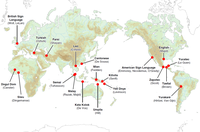Not biology, but culture shapes how we talk about the senses

Ever since Aristotle it has been assumed that the senses can be ordered hierarchically from higher to lower: sight, hearing, touch, taste and smell. Scientists expected that communicating about colours and shapes would be easier than about tastes and textures. A global experiment led by Professor Asifa Majid (formerly MPI Nijmegen & Radboud University, now at University of York) now has revealed that this is not the case everywhere: our culture says more about how we talk about perception than our biology. The study was published this week in PNAS.
Field research around the world
An international team of 26 scientists carried out fieldwork in 20 places across the globe, where they investigated 17 spoken languages and 3 signed languages. Every researcher used the same set of colours, shapes, textures, sounds, smells and tastes. Professor Majid: “Prior research has shown that English speakers find it easy to talk about the things that they can see, such as colours and shapes, but struggle to name the things that they smell. It was not known, however, if this was universally true across other languages and cultures.”
If the commonly accepted hierarchy of the senses were true, participants in the study should have been able to communicate about vision most easily, followed by sounds, such as loud and quiet; textures, such as smooth and rough; taste, such as sweet and sour; and smell, such as chocolate and coffee. That turned out not to be the case. For instance, speakers of Farsi and Lao could easily communicate about basic tastes, which turned out to be harder for English speakers — perhaps as a result of differences in how people engage with cultural cuisines. Professor Majid: “In a modern digital-led world, which typically engages sight and hearing, it could be worthwhile learning from other cultures in the way that taste and smell can be communicated. This could be particularly important for some professions, for instance the food industry.”
From Balinese sign language to Siwu in Ghana
Connie de Vos and Mark Dingemanse at the Centre for Language Studies of Radboud University and the Max Planck Institute for Psycholinguistics also contributed to the study. De Vos investigated Kata Kolok, a sign language of Bali, Indonesia: “Kata Kolok has a very effective way to communicate about tastes like sweet or sour: the sign for ‘taste’ is combined with the typical associated facial expression”.
Dingemanse, who carried out fieldwork on Siwu in Ghana: “Siwu speakers really excelled at describing textures. Turns out that Siwu is among the languages in which you can communicate about textures most efficiently. Perhaps this has to do with a rich culture of handiwork and food preparation.”
Professor Stephen C. Levinson, emeritus director of the Language & Cognition Department at MPI in which the research originated, was unavailable for comment because he is doing fieldwork on a remote island in the Coral Sea.
Culture shapes the language of perception
Professor Majid: “Scientists have spent hundreds of years trying to understand how human sensory organs work, concluding that sight is the most important sense. Our work shows that there is far more diversity in the linguistic coding of the senses than earlier work had imagined.”
The researchers found that living in a culture that produces patterned pottery made people better able to talk about shapes, and that cultures which placed particular value on their specialist musical heritage were able to communicate more efficiently on describing sounds. In short, there is no single universal hierarchy of the senses or a dichotomy between higher and lower senses: influenced by culture, every language has its own sensory story to tell.
- The study was published in the journal Proceedings of the National Academy of Sciences (PNAS).
- Majid, A., Roberts, S. G., Cilissen, L., Emmorey, K., Nicodemus, B., O'Grady, L., Woll, B., LeLan, B., De Sousa, H., Cansler, B. L., Shayan, S., De Vos, C., Senft, G., Enfield, N. J., Razak, R. A., Fedden, S., Tufvesson, S., Dingemanse, M., Ozturk, O., Brown, P., Hill, C., Le Guen, O., Hirtzel, V., Van Gijn, R., Sicoli, M. A., & Levinson, S. C. (2018). Differential coding of perception in the world’s languages. Proceedings of the National Academy of Sciences. doi:10.1073/pnas.1720419115 (PDF).
Share this page